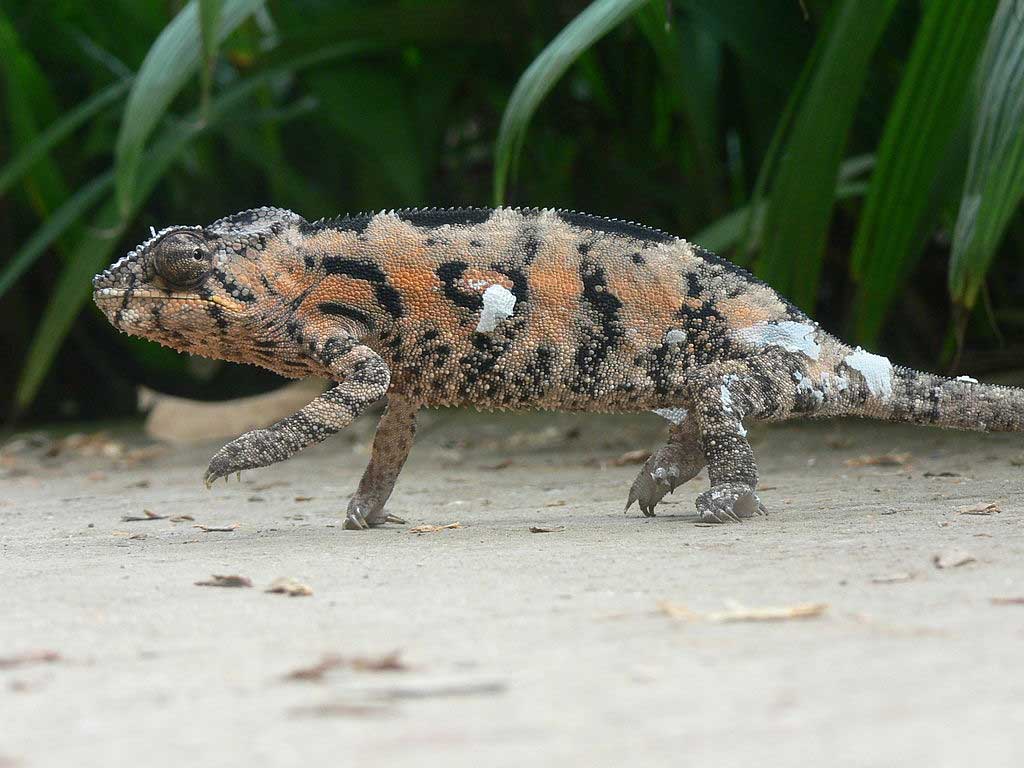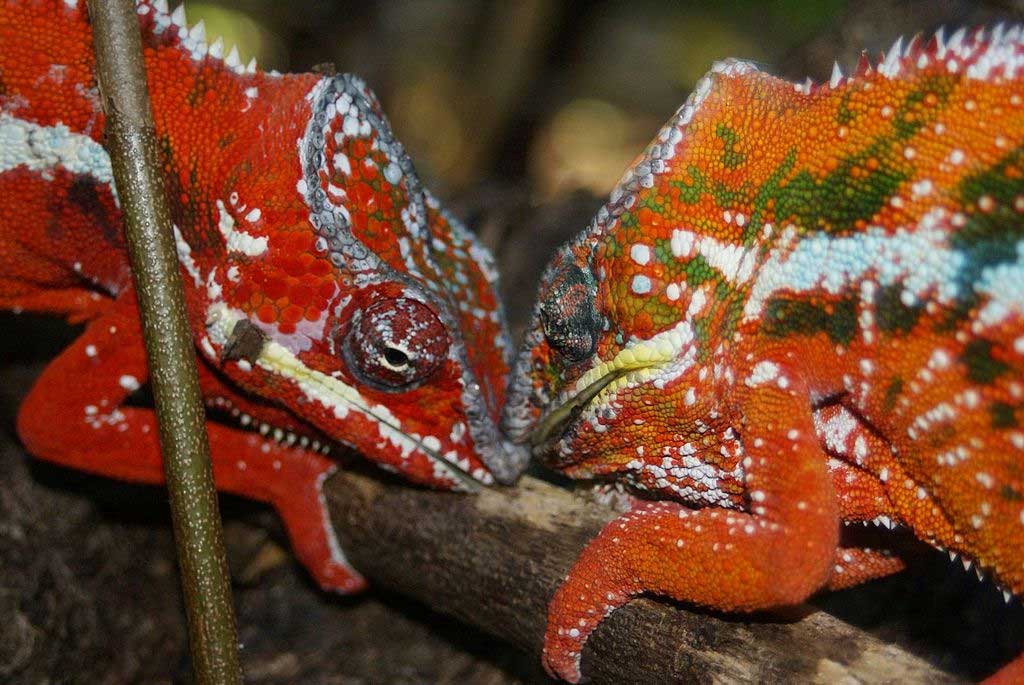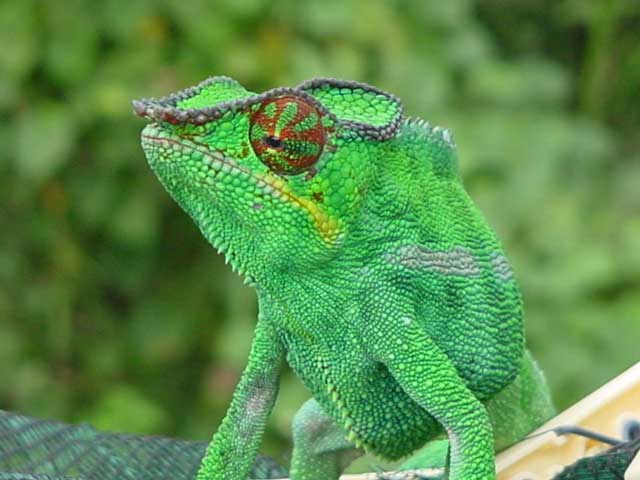
Content |
|---|
Origin / Distribution
The Furcifer pardalis, also known as Panther chameleon, are native to the island of Madagascar. They are distributed throughout the island, but they are locally abundant on the coasts of the center-east, northeast, north and northwest. The Furcifer pardalis they have also been introduced in areas such as Reunion and Mauritius.
Characteristics / Appearance
The most fascinating feature that has the Panther chameleon is its extraordinarily vibrant coloration. Adult chameleons are sexually dimorphic and males are recognized by their larger size, the swollen base of the tail indicating the presence of hemipenes, and have a wide range of coloration and patterns. Females are identified by being more uniformly pale green or pink in color, smaller, with a thinner tail base and sometimes with eggs detectable through the walls of the body. Adults can reach a length of 23 cm.. It is much more difficult to distinguish the sex of juvenile chameleons of less than 6 months of age due to their smaller size, its dull coloration and lack of hemipenial protrusion in males.
The coloration and pattern of the Panther chameleon varies significantly depending on its origin or location. Normally, the Panther chameleon of the Malagasy island Nosy Be are bluish green, emerald green or have a turquoise body. Northwest coast males are usually bright pink, with a yellowish-white stripe along the sides; this is commonly known as “the pink panthers”. Males may also be orange, red and dark green, with a large variation of spots, streaks and/or bands around the head and eyes.
The Panther chameleon lack a vomeronasal organ, an auxiliary olfactory sensory organ found in many animals. They also have no outer or middle ear, suggesting chameleons might be deaf. Chameleons have specialized tongue-like feet called zygodactyls.. On each foot, all five fingers are merged into a two-digit group and a three-digit group. On the front feet, the group of three toes is on the inside of the foot, and the group of two fingers is on the outside. This is reversed in the back foot, which gives them a secure and strong grip and allows them to maneuver horizontally or vertically in a wide variety of vegetation or structures. These specialized feet allow chameleons to hold on tightly to narrow branches.. The sharp claws on each finger help them climb and grip surfaces they can't hold on to tightly., like tree trunks.
Habitat
The Panther chameleon it inhabits mainly dry deciduous lowland forests, near belts of thin trees that line rivers and roads. This particular species seems to prefer open habitats that are not excessively shaded.. Scientists believe this is due to the need to colonize open spaces where they can sunbathe and males can use visual cues aimed at females. (during courtship) or for males to establish territories. Male panther chameleons also have a greater elevation range than females, most likely for territorial reasons.
Behavior
In general, the social structure of the Panther chameleon It is little known. It is known that the Furcifer pardalis, like most chameleons, is solitary and territorial, regardless of age or gender. Males tend to have larger distribution areas than females. Males often do not tolerate other males invading their shrub or tree of residence and will defend their territory by participating in an exhibition., chasing and possibly seriously injuring an intruding male. Hostility increases during the breeding season. It is not known whether females of Panther chameleon are intolerant of other females in general or only at nesting sites.
Chameleon eyes do not contain the melanin rods and pigments needed for night vision, which is why Furcifer pardalis is diurnal.
Reproduction
The females of Panther chameleon gestate fertilized eggs during 2 or 3 weeks. The young usually take between 6 months and a year to come out of the eggs. From that moment on, the offspring take others 6 months until they are sexually mature and have developed the coloration and size of an adult.
Courtship usually begins with displays by males. This usually includes the display of bright colors and a series of head movements that shake as they move towards the female.. Some males move slowly, with a choppy or spasmodic step, but others move very quickly and can be aggressive with females. Females that are not receptive or are gravid may run away or face the male chasing them with their mouths open while theirs., they stand on the hind legs and swing to discourage the male's advances. If the female seems interested, the male will mount it by grabbing its flanks and it will be placed to the right or left of its body.. Copulation takes place when the male everteja the closest of his two hemipens and introduces it into the cloaca of the female. Some species copulate for a few minutes and others for several hours, after which they usually follow different paths.
There is little information on the mating systems of the Panther chameleon, but some researchers have observed mating behavior consistent with serial polygyny. Studies in captivity of the Furcifer pardalis have shown that males have wider ranges than females. Females usually stay in a small area and are visited by males during the breeding season. This species has a slight pair bond, which consists of the males deciding to remain in the territory of the female for a period after breeding and probably defend this female from other males. Females that have already mated have shown aggressive behaviors towards successive males that walk through the territory. The successful male stays with the female for a brief period after mating and then continues to roam, probably looking for another partner.
Polygynous mating system
In most places, reproduction occurs between January and May, but this may vary geographically. Females in some areas can breed several times a year. After mating, the period of hard gestation of 3 to 6 weeks. Females dig burrows by digging with their front legs and then backing up on them to deposit 10 to 46 eggs. When they finish, bury eggs, fill in the tunnel and trample the earth to hide the location of the nest. Some females drag leaves and twigs over the place. This is the last act of motherhood of a chameleon, and their offspring shall be independent at birth. The young come out by opening a star-shaped opening at the end of the eggshell with the egg tooth., a sharp, calcified bump at the tip of the upper jaw that then comes off. The young weigh between 0,25 and 0,75 g at birth. Juveniles reach reproductive maturity at 6 months of age.
Females and males of the Furcifer pardalis show no more parental investment than creating and depositing eggs. The mother will try to protect the buried eggs from predators by hiding the location of the nest with twigs and leaves., but that is their last participation and the offspring will be independent immediately after hatching.
The females of Panther chameleon invest a lot of time and energy in making sure their young develop fully. The success of chameleon pups depends largely on the adequate amount of vitamin D from the mother during gestation. Ultraviolet light is known to (UV) the sun produces vitamin D in the skin of many vertebrates, like panther chameleons. UV-induced vitamin D serves as a signal in the body to help adjust the calcium-phosphorus balance in the body. Its main function is to stimulate calcium uptake from the intestine and reduce calcium reabsorption from bone. Eggs do not hatch if the mother does not have an adequate amount of vitamin D, either by exposure to UV rays or by food intake, because you can't supply enough vitamin D to your eggs to make it easier for developing embryos to form their skeleton. An important discovery made in recent years was that females seem to be able to perceive their internal vitamin D status., recognize an external source of UV rays and voluntarily expose themselves to that source when they have a vitamin D deficiency. On the other hand, choose to avoid elevated UV sources when they have enough vitamin D.
Food
The Furcifer pardalis they are considered opportunistic hunters because they wait for prey to pass within reach of their long tongues. They feed mainly on terrestrial invertebrates and, very rarely, of plant material. They have the ability to turn and focus their eyes separately to observe two different objects simultaneously.. This allows them to have an arc of vision 360 degrees around their body while remaining completely still and camouflaged. When the prey is in sight, both eyes can focus in the same direction, providing acute stereoscopic vision and depth perception.
Chameleons have very unique languages specialized in capturing their prey.. An extensive study carried out in the year 2000 revealed the complexities of chameleon language functioning. Prey capture was often attributed only to adherence to the lingual pad., but now scientists believe that the speed and shape of the tongue also create a suction device.. The hyoid bone is a piece of cartilage that extends into the mouth from the throat bones. (called hyaline apparatus) and is attached to the long tongue of the chameleon. This is where the tongue rests when not in use. The tongue is thrown from the hyoid bone with the use of ringed muscles on the tongue. This complex structure is made up of cartilage, muscles, nerves, glands and tissues that work together to create an incredibly fast and effective tongue to grab your food.
Life expectancy
Although males can exceed five years of age in captivity, most Panther chameleon wilderness only survives one or two years after maturity. Females have a shorter half-life in the wild and in captivity due to the stress of reproduction and oviposition..
Threats to the species
The Panther chameleon is one of the most sought-after chameleon species in the international pet trade due to its beautiful coloration and the success of its captive breeding..
Tighter trade quotas have been applied and recent export levels are within a sustainable range. There is currently little risk to this chameleon species, apart from the threat of continued habitat loss and modification.
The local population uses relatively little of the Furcifer pardalis within its range. Chameleons are not used very often in the local kitchen. But, Furcifer pardalis is caught and sold in the international trade of live animals. United States, Europe and Asia are the main participants in this traffic.
The "Panther chameleon" in captivity
The terrarium
The Panther chameleon is kept in a tall terrarium, but does not require as much ventilation as other chameleon species. These animals must be kept individually. The terrarium must have at least 100 x 60 x 150cm. Higher would be better.
Food
The diet of the Panther chameleon consists mainly of insects such as crickets, crickets, grasshopper, flies, fruit flies, cockroaches, rarely wax moth caterpillars… but be careful when feeding him!! These animals gain weight easily and can develop gout. It also, feeds with leaves, colorful flowers, or possibly some fruit.
no lettuce, iceberg lettuce or similar, since its calcium-phosphorus content is unfavorable. And cabbage or spinach should rarely be fed oxalic acid….
Additional vitamin and mineral supplements are recommended.
Lighting and temperature
The temperature in the terrarium of the Panther chameleon should be 22-28°C (locally 35-40°C) during the day and between 16-22°C at night. The humidity should be 60-80% and around the 100% At night.
In the terrarium of a Panther chameleon there must be numerous possibilities to climb, preferably a tree (Ficus benjamina), remained, other plants, cork tubes and bark, which also offer hiding places.
Good lighting and ultraviolet light (30% of UVA rays and 5-10% UVB) are necessary for your well-being, as well as a place to sunbathe. UV radiation is very important and necessary. In the case of females, it is necessary to provide a suitable place for laying eggs or several possibilities.
A spray system can be installed in the terrarium, that sprays water repeatedly (about three to four times a day), or a nebulizer can be installed in the terrarium. For fluid intake, a dropper must be installed that is always cleaned.
Hibernation
The Panther chameleon it is usually more inactive in winter and here you can simulate a kind of hibernation by lighting. Reduce daily lighting time by two to three hours over a period of about two months. Hibernation is very important for animals to regulate body functions and stay healthy. But here you have to observe the animals well to see if they are prepared for rest.. This can be noticed in the behavior when the animal calms down on its own in autumn..
Reproduction
The Panther chameleon puts up to 46 eggs. They are quite aggressive animals, so you have to be careful when mating. Raising young animals individually in small terrariums.
It is essential to provide enough calcium and vitamins in breeding.
Housing conditions
To keep the Furcifer pardalis (Panther chameleon) we recommend creating the following conditions. Especially regarding the minimum size, we ask you to keep in mind that optimal conditions can only be achieved in much larger terrariums.
- temperatures during the day: 22° to 28 °C (locally 35-40°C)
- Night temperatures: 16-22°C
- Humidity: 60-80% during the day and approx. 100% At night)
- Minimum size of the terrarium: from 120x60x150cm for an animal (better higher)
Buy one "Panther chameleon"
The price of a "Panther chameleon" at the exotic animal market, ranges between 300 – 500 EUR.
Images "Panther chameleon"
|
|---|
Videos "Panther chameleon"
Alternative names:
1. Panther chameleon (English).
2. Caméléon panthère, Endormi (French).
3. Pantherchamäleon (German).
4. Camaleão-pantera (Portuguese).
5. "Camaleón pantera", Endormi de La Reunión, Lendormi, Zendormi (español).








